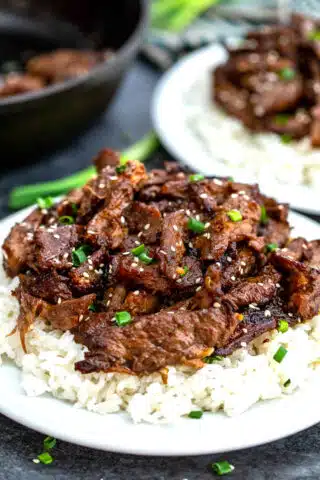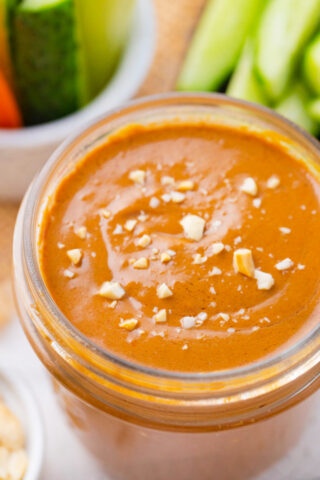Crispy General Tso’s Chicken
The first time I tasted General Tso’s Chicken, I knew it would become a favorite, so after experimenting with different coatings and sauces, I have finally perfected my homemade version of it. Crispy and crunchy on the outside, tender and juicy on the inside, coated in a flavorful, sticky sauce, this recipe takes just 30 minutes to make, and it’s so much better than takeout.
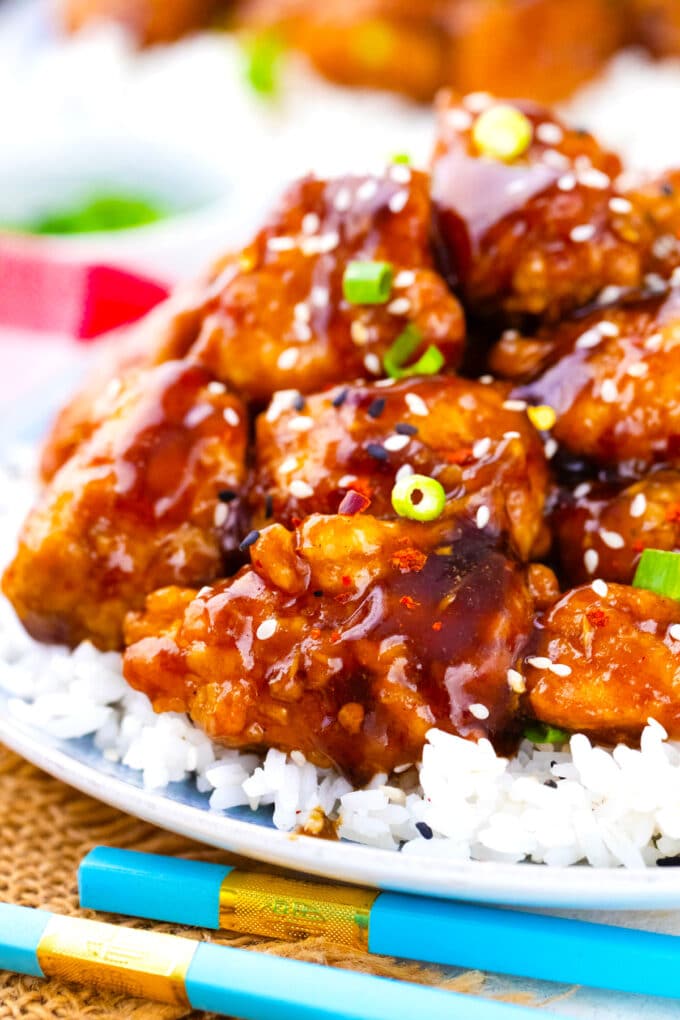
I am a massive fan of Asian recipes, and I have dedicated a lot of time to recreating and perfecting them at home. My Hunan Beef and Korean Ground Beef are other must-tries that I am proud to share after spending hours in the kitchen to ensure the authentic and irresistible taste.
Table of contents
I have shared with you many times my kitchen hack of having a jar of General Tso’s sauce in the fridge. It has saved me so many times from bland weeknight dinners. If you make the sauce in advance, making this recipe takes just around 20 minutes; truly, it’s way quicker and better than ordering delivery.
Each bite is a harmony of textures and flavors. Crispy, saucy, sticky, lightly spicy, and with the ideal zing from the ginger and garlic, you can confidently add this General Tso Chicken to your weeknight menu. Guaranteed to become a family favorite, be prepared that everyone will be impressed when you serve this popular restaurant dish at home.
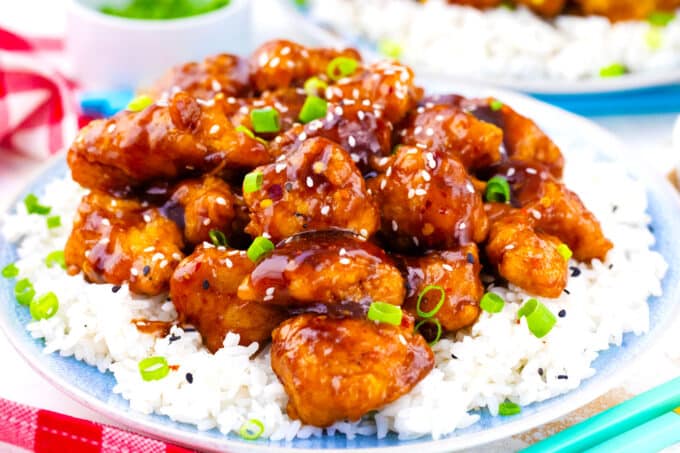
Why you will love this recipe
- Faster than take-out: Instead of going out, I can make my favorite take-out meal at home, and it tastes better than the restaurant stuff!
- Save money: Instead of paying over $50 to feed the family, I can make this dish for less than $20.
- Simple ingredients: All I need is chicken, eggs, seasonings, and some basic Asian sauce ingredients to make a Chinese recipe that everyone loves.
- Versatile dish: I like that I can serve this with rice or noodles as well as in a bowl with vegetables.
What you will need
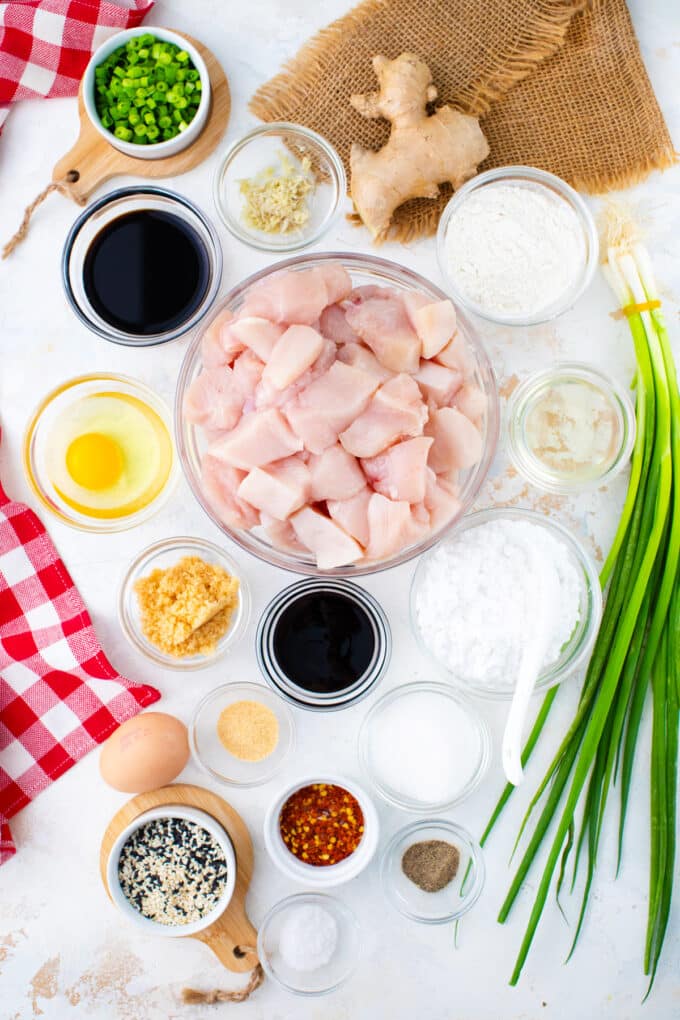
- Chicken: I use 2½ pounds of boneless, skinless chicken breasts cut into one-inch chunks.
- Dry ingredients: I mix all-purpose flour with cornstarch because the cornstarch absorbs moisture and creates a crispier coating. To add flavor, I also add salt and pepper.
- Wet ingredients: I also dip the chicken in beaten eggs as a natural adhesive to get the breading to stick to the chicken.
For the sauce:
- Liquids: Soy sauce is used to add a salty umami flavor to the sauce, while the hoisin sauce is sweeter with a more caramelized taste. Rice vinegar adds a tangy flavor that balances the sweetness, complementing the rich, meaty taste of the chicken broth. Be sure to choose low-sodium varieties to avoid making the sauce too salty.
- Seasonings: White sugar gives the sauce plenty of sweetness while the brown sugar adds a richer, buttery caramel taste. Garlic powder is added as well to give it that bold, pungent flavor.
- Herbs: I like to use freshly minced ginger instead of powder for this sauce because it tastes more potent and has a lively aroma to elevate the whole flavor of the sauce. The red pepper flakes add a tiny bit of heat. I also like to add some chopped green onions as garnish for flavor and color.
How to make
Prepare the coating: First, I mix the flour, cornstarch, salt, and pepper in a large bowl. Then, I beat the eggs in another bowl.
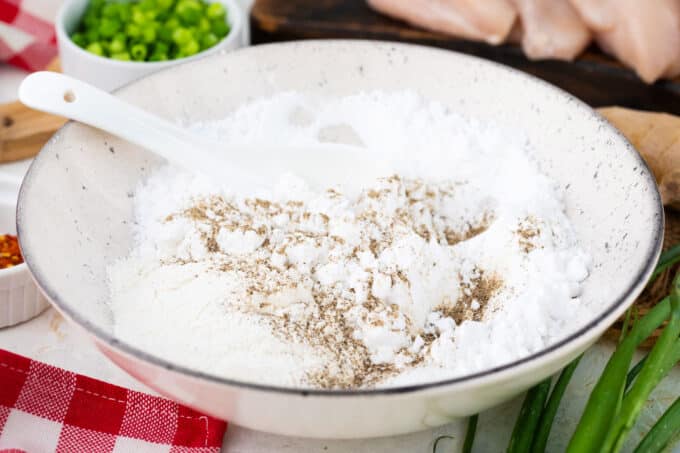
Heat the oil: While I dip the chicken, I get two inches of oil started in a deep pan over medium-high heat. Then, I dip the chicken in the eggs before tossing them in the cornstarch mixture.
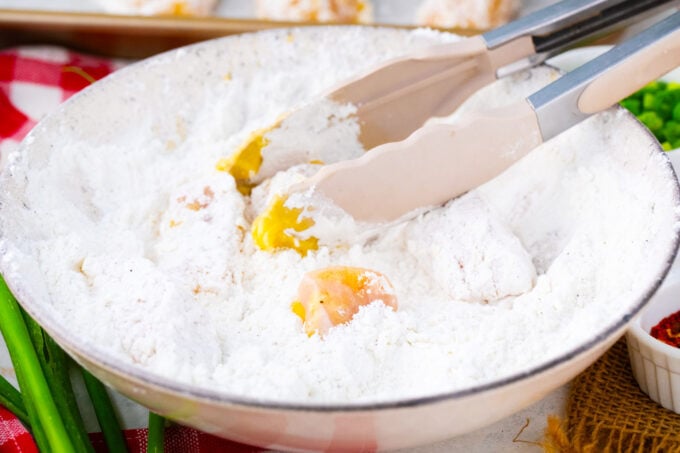
Fry the chicken: I cook them in hot oil in batches, ensuring the temperature reaches 360 to 375°F, and making sure there is plenty of room for them to fry. When they are crispy and golden brown, I remove them to a wire rack until they are all finished.
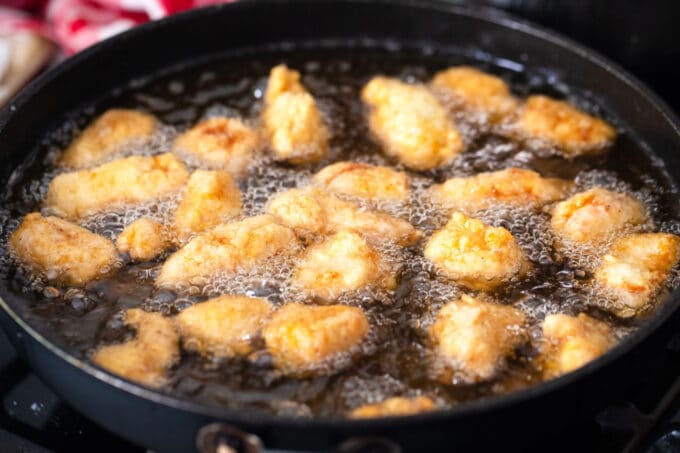
Mix the sauce: Once they are done, I add all the sauce ingredients to the pan, whisking well, and let it cook for three to five minutes over medium heat.
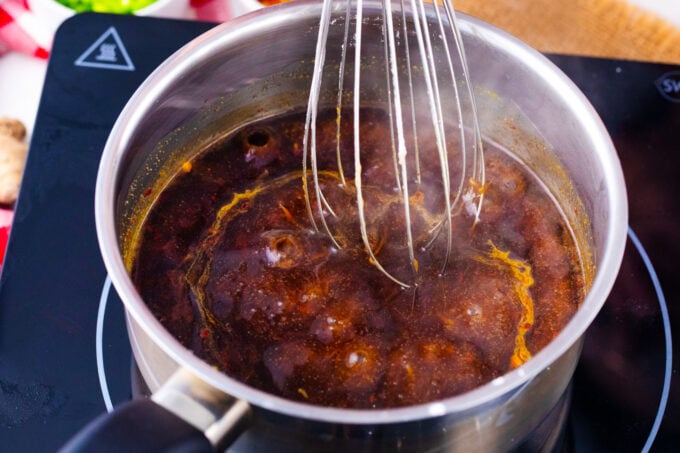
Combine: When it starts to thicken, add the chicken to the pan and stir until it is coated.
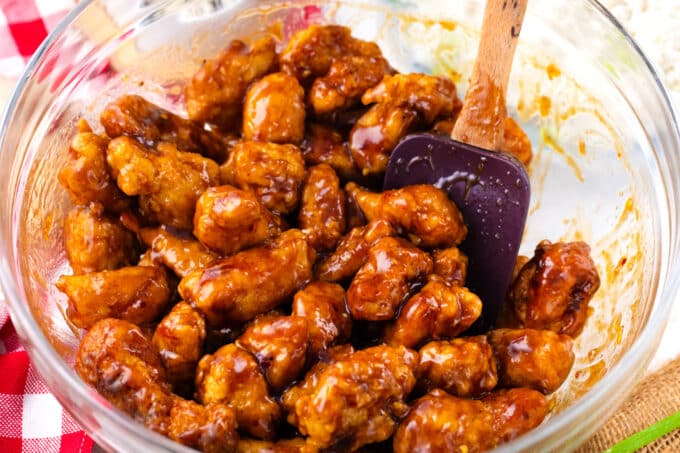
Garnish and serve: After one to two minutes, remove the chicken and serve it garnished with green onions and sesame seeds.

Expert tip
Double-fring the chicken
Although I don’t do it in this recipe, many recipes do call for frying it twice to achieve an extra-crispy crust. The first fry removes the moisture from the surface, and the second fry crisps it to a golden-brown perfection. The first fry also cooks the chicken, so the second time only takes one or two minutes. The reason I don’t do this is that I like my General Tso chicken to be lightly breaded. It is a matter of personal preference.
More tips to consider:
- Have everything ready before starting. This is a fast-moving recipe, so everything should be measured and set out right where they can be reached.
- Cut the chicken into pieces about the same size so they cook evenly.
- Don’t forget to shake off the excess egg and flour so it does not get all caked up.
- Also, don’t crowd the pan. This can cause it to steam instead of frying, which will make the chicken soggy.
- It is essential to remove the chicken from the pan while making the sauce. It has to cool off before adding it back to the sauce to get a crispy coating.
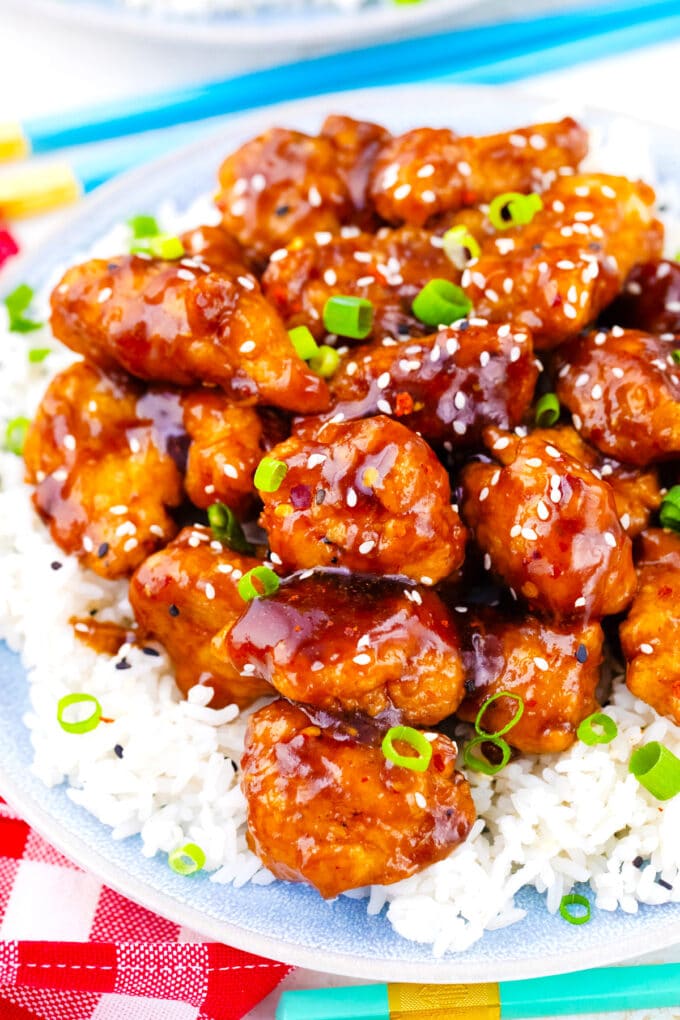
Recipe variations and add-ins:
- Different cut: Sometimes I use boneless, skinless chicken thighs. They have a richer, meatier flavor and are juicier as well.
- Another meat: For a completely different meat, try using pork or turkey. I have used turkey breast for this, and it tastes delicious.
- Spicy Tso: Those who enjoy spicy food enjoy it when I add sriracha sauce to my General Tso chicken. Sometimes I also add cayenne pepper.
- Add veggies: To make this a heartier meal, sometimes I add broccoli and cauliflower florets.
- Baked Tso: Instead of frying the chicken, it can be baked at 400°F for a healthier meal. Then, toss it in the sauce on the stove.
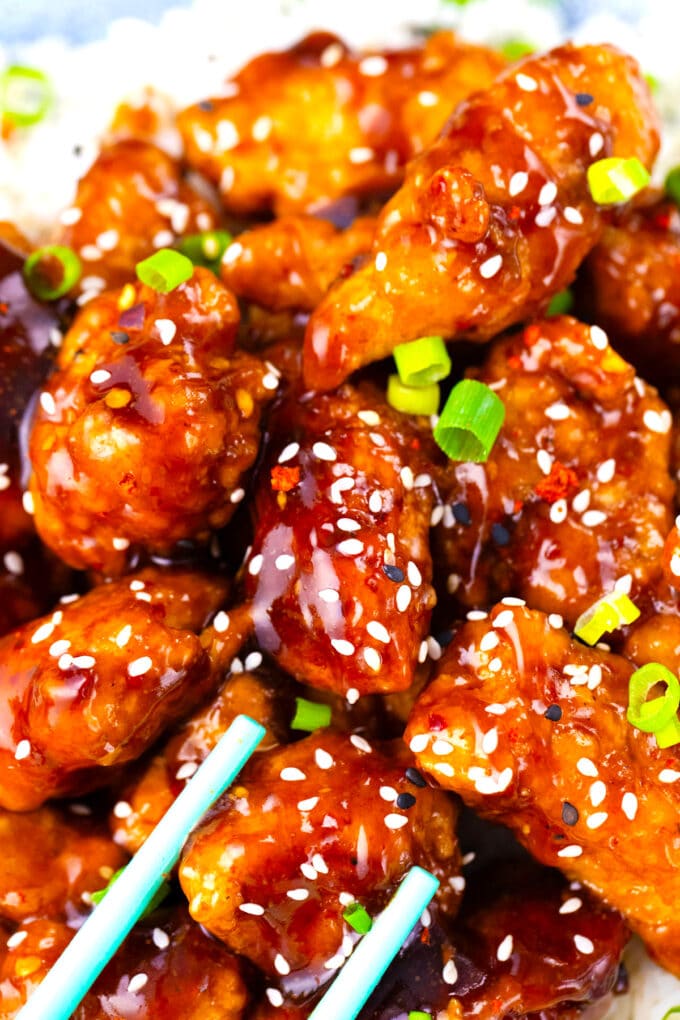
Serving suggestions:
My favorite way to serve General Tso’s chicken is on top of rice. But instead of using regular white rice, I use my slightly sweet and totally delicious coconut rice. It only takes 25 minutes to make, and it tastes perfect with the slightly spicy flavor of this sauce. For those who are watching their carb intake, try my low-carb cauliflower rice. It has a nutty flavor and hardly any carbs because it is made from cauliflower!
If you prefer the regular buttery rice but want it quickly, try my Instant Pot stick of butter rice. It is so buttery delicious, you may not want to put the sauce on top of it. I usually make extra to eat on the side. Instead of rice, sometimes I make noodles. My soba noodles are the perfect solution. They only take a few minutes, and everyone loves them, especially the kids.
How to store leftovers:
- Refrigerate: I store my leftovers in an airtight container in the fridge, where they will stay fresh for several days.
- Freezing: To keep them longer, I place the leftovers in a freezer bag, and they can stay frozen for up to three months.
- Defrost: For the best results, I thaw leftovers in the refrigerator overnight.
- Reheating: To reheat, I like to put the chicken in an oiled wok or skillet over medium-high heat. It only takes a few minutes to have it heated up and crispy. It can also be reheated in the microwave, but it won’t be crispy.
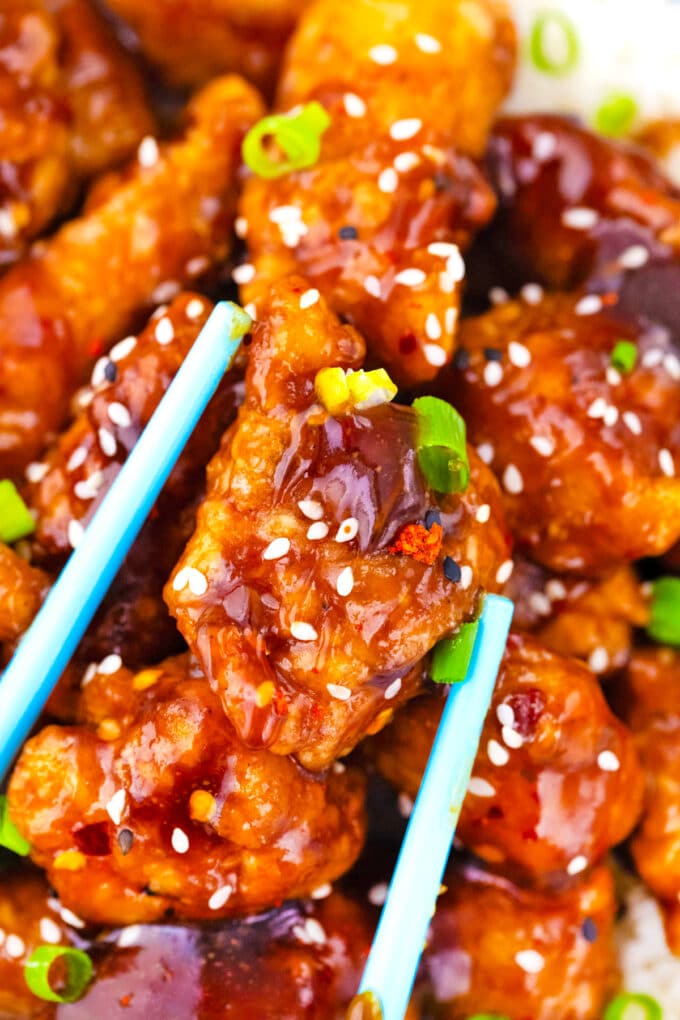
Frequently asked questions
If the oil were not hot enough, the chicken would absorb the oil rather than being fried in it. The temperature of the oil should be 360 to 375 degrees F. You can check this with a hot oil thermometer, but a candy thermometer will also work as long as it is made for high temperatures. It may also be that the chicken pieces were too close together. The pieces need room to fry so they do not just end up steaming instead. I always cook in batches so there is plenty of room for each piece.
Cooking the chicken too long or at too high a temperature can also draw out all its moisture, causing it to be dry and chewy. I have overcooked my chicken many times before, as everyone has, because it is easy to do. The trick is to protect the meat by coating it with egg and breading and then only cooking it for three minutes at 360 to 375 degrees F. Some people also use a velveting technique to keep it moist. This is done with baking soda, cornstarch, egg white, and sesame oil.
One of the reasons for hard chicken pieces is overcooking. Make sure you are only cooking the meat for a few minutes. Since they are small pieces, they only need to be cooked for about three minutes. Another issue could be the chicken itself. Chicken breast is more susceptible to getting hard. Try using chicken thighs instead because they are juicier and stay tender longer.
The primary reason this occurs is due to the high-sodium ingredients. That is why I call for low-sodium chicken broth and soy sauce. These two ingredients alone have a high amount of sodium in them, so I always use the low-sodium variety. If you used the low-sodium varieties and the sauce is still too salty, it may be because too much sodium was lost during the cooking process. Just add some water to it for dilution, and this should take care of the problem.
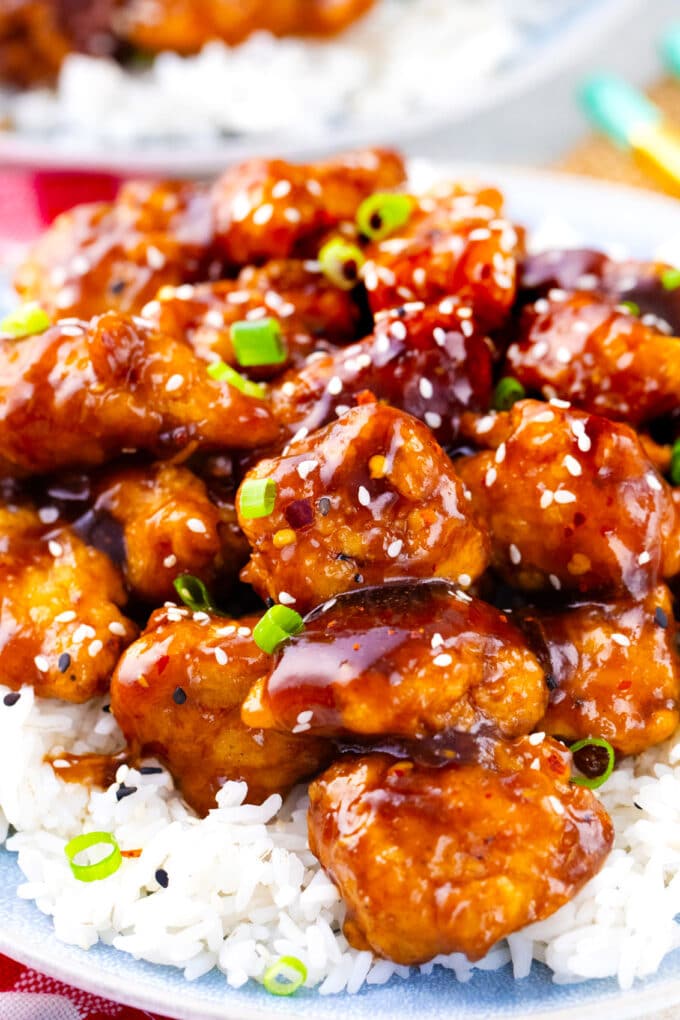
More easy Asian recipes:
Loved this recipe? I’d love to hear from you! 💛 Leave a 5-star rating ⭐️ in the recipe card below and share your thoughts in the comments – I read and appreciate every single one!
Let’s stay connected! Follow me on Facebook, Instagram, Pinterest, and YouTube for more delicious, sweet and savory recipes. Have a question? Ask in the comments, and I’ll be happy to help! 😊 with love Catalina!
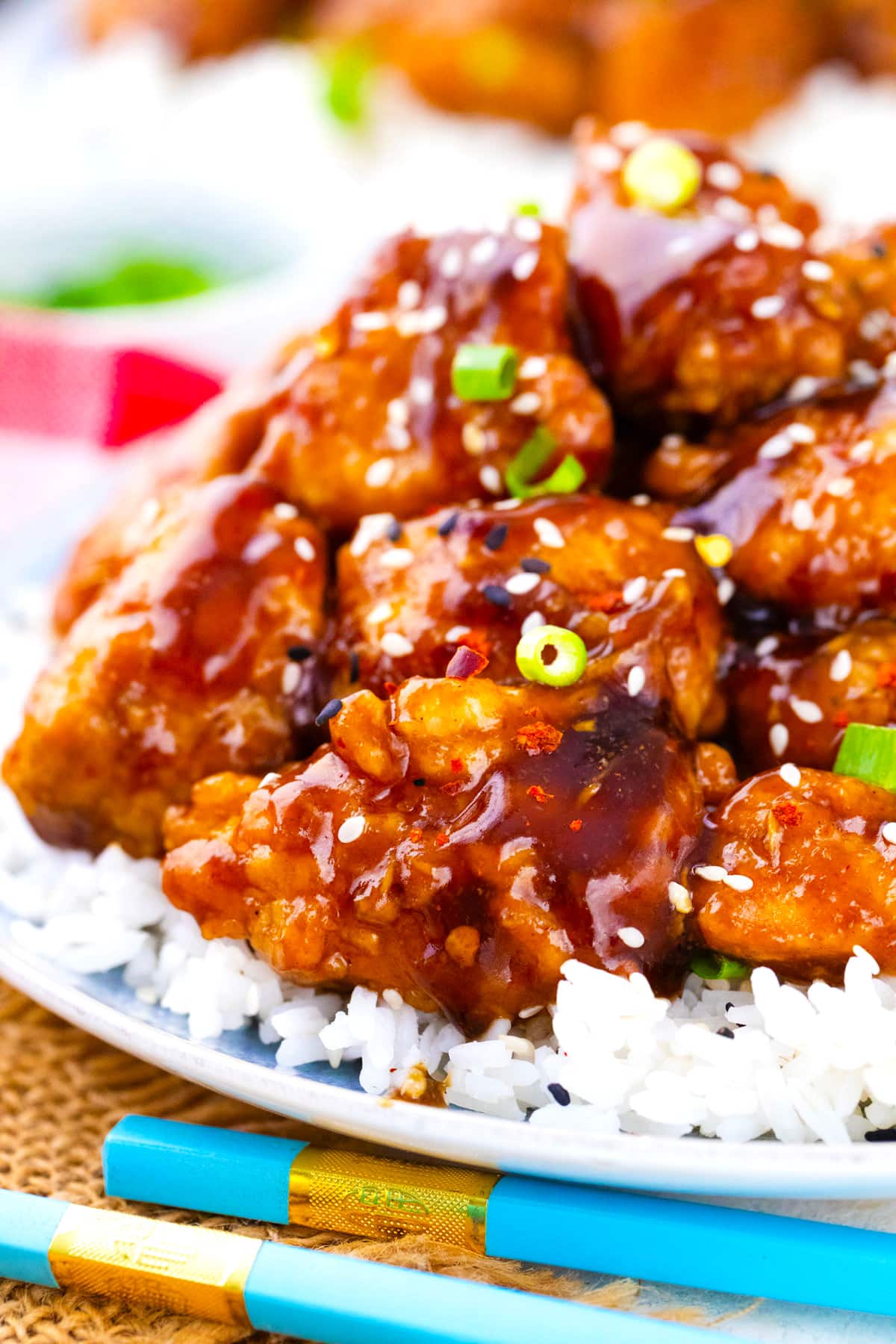
General Tso Chicken
Ingredients
Chicken:
- 2 1/2 pounds chicken breasts or boneless chicken thighs cut into 1-inch chunks
- 1 cup cornstarch
- 1/4 cup all-purpose flour or gluten-free flour
- 1/2 teaspoon salt
- 1/4 teaspoon ground black pepper
- 2 eggs beaten
- Canola oil for frying
General Tso Sauce:
- 3 tablespoons rice vinegar
- 1/3 cup soy sauce or amino acids for gluten-free version
- 2 tablespoons hoisin sauce
- 1/2 cup chicken broth low sodium
- 3 tablespoons white sugar
- 3 tablespoons brown sugar
- 1 teaspoon fresh ginger minced
- 1/2 teaspoon garlic powder
- 1/4 teaspoon red pepper flakes
- 1 tablespoon cornstarch
Garnish:
- Green onions chopped
- Sesame seeds
Instructions
Chicken:
- In a large, shallow bowl, whisk cornstarch, flour, salt, and black pepper.
- Add beaten eggs to another bowl.
- Pour about 2 inches of canola oil into a deep frying pan and heat it over medium-high heat.
- Dip the chicken pieces into the beaten eggs.
- Add the chicken chunks to the cornstarch mixture and toss until well-coated. Work in batches.
- Cook it in batches in the hot oil until golden and crispy.
- Remove to a plate and set aside.
Sauce:
- Discard the oil and wipe the skillet clean.
- Add all the Sauce ingredients to the same skillet and whisk to combine. Cook it over medium heat for 3-5 minutes until it starts to simmer.
- Continue to cook for 5 minutes, until the mixture begins to thicken. Once the sauce is thickened, add the chicken and stir to coat.
- Remove from heat. Serve garnished with green onions and sesame seeds.
Video
Notes
Double-fring the chicken
Although I don’t do it in this recipe, many recipes do call for frying it twice to achieve an extra-crispy crust. The first fry removes the moisture from the surface, and the second fry crisps it to a golden-brown perfection. The first fry also cooks the chicken, so the second time only takes one or two minutes. The reason I don’t do this is that I like my General Tso chicken to be lightly breaded. It is a matter of personal preference.More tips to consider:
- Have everything ready before starting. This is a fast-moving recipe, so everything should be measured and set out right where they can be reached.
- Cut the chicken into pieces about the same size so they cook evenly.
- Don’t forget to shake off the excess egg and flour so it does not get all caked up.
- Also, don’t crowd the pan. This can cause it to steam instead of frying, which will make the chicken soggy.
- It is essential to remove the chicken from the pan while making the sauce. It has to cool off before adding it back to the sauce to get a crispy coating.


